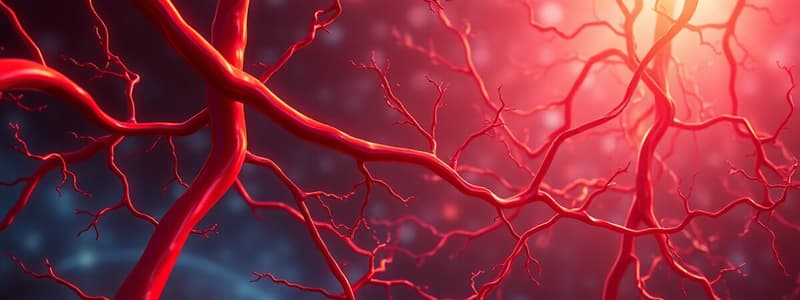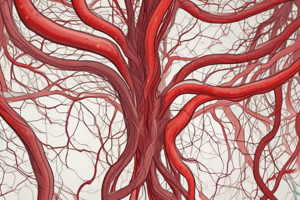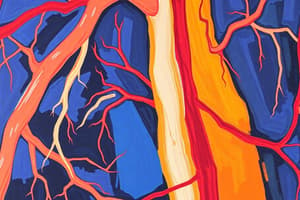Podcast
Questions and Answers
What role do baroreceptors play in blood pressure regulation?
What role do baroreceptors play in blood pressure regulation?
- They adjust blood volume directly through urine output.
- They respond to changes in stretch and pressure. (correct)
- They assist in the movement of blood through veins.
- They increase blood pressure by reducing heart rate.
Which mechanism is involved in long-term regulation of blood pressure?
Which mechanism is involved in long-term regulation of blood pressure?
- Muscular pump
- Renin-angiotensin-aldosterone mechanism (correct)
- Respiratory pump
- Epinephrine secretion
What primarily drives the movement of fluid out of capillaries during filtration?
What primarily drives the movement of fluid out of capillaries during filtration?
- Net Filtration Pressure
- Tissue Perfusion
- Colloid Osmotic Pressure
- Hydrostatic Pressure (correct)
What causes edema in the body?
What causes edema in the body?
What condition is characterized by plaque buildup in arteries leading to potential health risks?
What condition is characterized by plaque buildup in arteries leading to potential health risks?
What is the primary function of capillaries in the circulatory system?
What is the primary function of capillaries in the circulatory system?
Which type of vessel is specifically responsible for active vasoconstriction?
Which type of vessel is specifically responsible for active vasoconstriction?
What component of blood vessels is responsible for preventing backflow in veins?
What component of blood vessels is responsible for preventing backflow in veins?
Which of the following types of capillaries is considered the most permeable?
Which of the following types of capillaries is considered the most permeable?
What is the main determinant of blood flow resistance in vessels?
What is the main determinant of blood flow resistance in vessels?
During which phase of the cardiac cycle is systolic blood pressure measured?
During which phase of the cardiac cycle is systolic blood pressure measured?
What does pulse pressure represent in the context of blood pressure measurements?
What does pulse pressure represent in the context of blood pressure measurements?
What condition is characterized by dilated veins due to incompetent valves?
What condition is characterized by dilated veins due to incompetent valves?
What is the primary function of the respiratory system?
What is the primary function of the respiratory system?
Which part of the upper respiratory tract is primarily responsible for shared passage of air and food?
Which part of the upper respiratory tract is primarily responsible for shared passage of air and food?
What role do Type II cells in the alveoli play?
What role do Type II cells in the alveoli play?
What is a potential cause of laryngitis?
What is a potential cause of laryngitis?
Which anatomical feature separates the right and left nasal cavities?
Which anatomical feature separates the right and left nasal cavities?
What is the function of pleural fluid?
What is the function of pleural fluid?
What phenomenon explains the inverse relationship between pressure and volume in the respiratory system?
What phenomenon explains the inverse relationship between pressure and volume in the respiratory system?
What condition is caused by inadequate surfactant in premature infants?
What condition is caused by inadequate surfactant in premature infants?
Which statement accurately describes tidal volume (TV)?
Which statement accurately describes tidal volume (TV)?
What is the main function of hemoglobin in the context of gas exchange?
What is the main function of hemoglobin in the context of gas exchange?
Which factor is NOT monitored by chemoreceptors to control respiration?
Which factor is NOT monitored by chemoreceptors to control respiration?
What describes the process of external respiration?
What describes the process of external respiration?
What is the primary cause of chronic obstructive pulmonary disease (COPD)?
What is the primary cause of chronic obstructive pulmonary disease (COPD)?
Which gas law states that the total pressure equals the sum of partial pressures of gases?
Which gas law states that the total pressure equals the sum of partial pressures of gases?
What happens during hypercapnia?
What happens during hypercapnia?
Which of the following is the correct definition of residual volume (RV)?
Which of the following is the correct definition of residual volume (RV)?
Flashcards
Blood Vessel Types
Blood Vessel Types
Arteries carry blood away from the heart (oxygenated, except in pulmonary and umbilical vessels); Veins return blood to the heart (deoxygenated, except in pulmonary and umbilical vessels); Capillaries are exchange vessels.
Tunica Intima
Tunica Intima
The innermost layer of blood vessel walls, made of endothelium (smooth lining) to reduce friction.
Elastic Arteries
Elastic Arteries
Large arteries (like the aorta) with elastin, acting as pressure reservoirs to maintain continuous blood flow.
Blood Flow Formula
Blood Flow Formula
Signup and view all the flashcards
Systolic Pressure
Systolic Pressure
Signup and view all the flashcards
Capillary Types
Capillary Types
Signup and view all the flashcards
Arterioles Function
Arterioles Function
Signup and view all the flashcards
Blood Pressure
Blood Pressure
Signup and view all the flashcards
Capillary blood pressure
Capillary blood pressure
Signup and view all the flashcards
Venous Blood Pressure
Venous Blood Pressure
Signup and view all the flashcards
Short-term blood pressure regulation
Short-term blood pressure regulation
Signup and view all the flashcards
Net Filtration Pressure
Net Filtration Pressure
Signup and view all the flashcards
Edema
Edema
Signup and view all the flashcards
Upper Respiratory Tract
Upper Respiratory Tract
Signup and view all the flashcards
Lower Respiratory Tract
Lower Respiratory Tract
Signup and view all the flashcards
Alveoli
Alveoli
Signup and view all the flashcards
What is surfactant and why is it important?
What is surfactant and why is it important?
Signup and view all the flashcards
What is the respiratory zone?
What is the respiratory zone?
Signup and view all the flashcards
Inspiration
Inspiration
Signup and view all the flashcards
Boyle's Law
Boyle's Law
Signup and view all the flashcards
Expiration
Expiration
Signup and view all the flashcards
Tidal Volume (TV)
Tidal Volume (TV)
Signup and view all the flashcards
Inspiratory Reserve Volume (IRV)
Inspiratory Reserve Volume (IRV)
Signup and view all the flashcards
Expiratory Reserve Volume (ERV)
Expiratory Reserve Volume (ERV)
Signup and view all the flashcards
Residual Volume (RV)
Residual Volume (RV)
Signup and view all the flashcards
Vital Capacity (VC)
Vital Capacity (VC)
Signup and view all the flashcards
Total Lung Capacity (TLC)
Total Lung Capacity (TLC)
Signup and view all the flashcards
Dalton's Law
Dalton's Law
Signup and view all the flashcards
Henry's Law
Henry's Law
Signup and view all the flashcards
Study Notes
Blood Vessels Overview
- Blood vessels are categorized into arteries, capillaries, and veins.
- Arteries carry oxygenated blood (except pulmonary and umbilical) away from the heart.
- Capillaries are exchange vessels for gas, nutrient, and waste exchange with tissues.
- Veins carry deoxygenated blood (except pulmonary and umbilical) towards the heart.
- All blood vessels (except capillaries) have three layers called tunics.
- Tunica intima: Innermost layer, made of endothelium for smooth blood flow.
- Tunica media: Middle layer, composed of smooth muscle for controlling vasoconstriction/vasodilation.
- Tunica externa: Outer layer, made of collagen fibers; anchors the vessel.
Arteries
- Elastic arteries (e.g., aorta) are large and contain elastin for maintaining continuous blood flow.
- Muscular arteries are smaller and deliver blood to specific organs via active vasoconstriction.
- Arterioles are the smallest arteries and regulate blood flow into capillaries by controlling resistance and blood pressure.
Capillaries
- Capillaries are thin-walled (endothelium and basement membrane), enabling efficient exchange.
- Continuous capillaries are the least permeable, found in tissues like skin and muscles.
- Fenestrated capillaries have pores for increased permeability, found in organs needing high filtration (e.g., kidneys).
- Sinusoidal capillaries are the most permeable, having large gaps for bulk exchange, found in tissues like the liver and bone marrow.
- Capillary beds are networks of capillaries between arterioles and venules, with blood flow controlled by precapillary sphincters.
Veins
- Veins have thin walls and large lumens; they act as blood reservoirs, storing approximately 65% of the blood.
- Venous valves prevent backflow, especially in limbs.
- Clinical Notes:
- Varicose veins are dilated veins due to incompetent valves.
- Deep vein thrombosis are clots in deep veins, leading to possible complications like pulmonary embolism (a clot traveling to the lungs).
Blood Flow, Pressure, and Resistance
- Blood flow (F) is the volume of blood flowing through a vessel.
- Blood pressure (BP) is the force exerted by blood on vessel walls.
- Resistance (R) is the opposition to flow, significantly influenced by vessel diameter.
- Flow is directly proportional to the pressure gradient and inversely proportional to resistance (F = ΔP/R).
Systemic Blood Pressure
- Arterial blood pressure:
- Systolic pressure (approx. 120 mmHg) – highest pressure during ventricular contraction.
- Diastolic pressure (approx. 80 mmHg) – lowest pressure during relaxation.
- Pulse pressure is the difference between systolic and diastolic pressure.
- Capillary blood pressure is low to prevent rupture and facilitate efficient exchange.
- Venous blood pressure is low but aided by the muscular and respiratory pumps.
Blood Pressure Regulation
- Short-term regulation:
- Neural controls: Baroreceptors (responding to stretch) and chemoreceptors (responding to O₂, CO₂, and pH) affect blood pressure.
- Hormonal controls: Epinephrine and norepinephrine increase blood pressure, while atrial natriuretic peptide (ANP) decreases it.
- Long-term regulation: Renal mechanisms adjust blood volume via urine output and the renin-angiotensin-aldosterone system.
Tissue Perfusion and Blood Flow
- Tissue perfusion delivers oxygen/nutrients and removes waste, adjusted based on tissue needs (e.g., increased blood to muscles during exercise).
- Autoregulation:
- Metabolic controls: Local chemical changes (O₂ and CO₂) affect blood flow.
- Myogenic controls: Vascular smooth muscle responds to pressure changes.
Capillary Exchange
- Bulk flow across capillaries depends on:
- Hydrostatic pressure (HP): Pushes fluid out of capillaries.
- Colloid osmotic pressure (OP): Pulls fluid into capillaries.
- Net filtration pressure (NFP): Positive at the arterial end for filtration, negative at the venous end for reabsorption.
Clinical Notes
- Edema is caused by increased hydrostatic pressure or decreased colloid osmotic pressure, resulting in fluid buildup in interstitial spaces.
- Atherosclerosis is plaque buildup in arteries, causing hypertension, heart attacks, and stroke.
- Aneurysms are weakened and ballooning arterial walls, risking rupture.
Developmental Aspects and Circulatory Pathways
- Fetal circulation:
- Foramen ovale connects atria, bypassing non-functional lungs.
- Ductus arteriosus connects pulmonary trunk to aorta.
- Vascular aging: Increased risk of varicose veins and atherosclerosis.
Studying That Suits You
Use AI to generate personalized quizzes and flashcards to suit your learning preferences.




